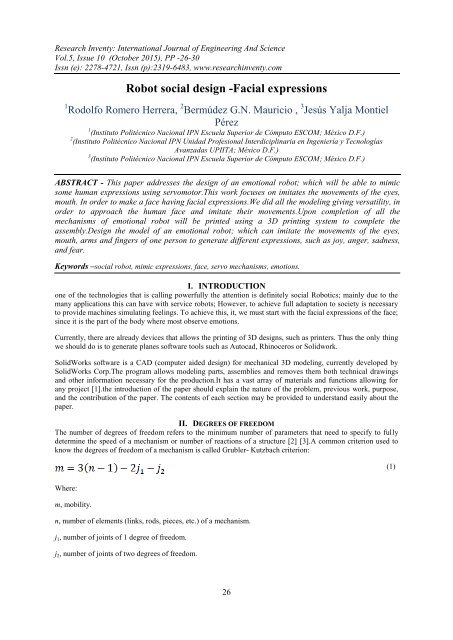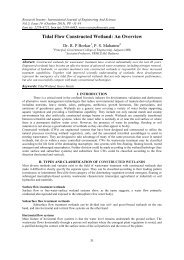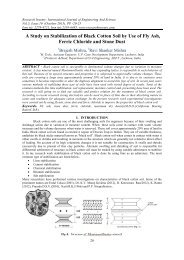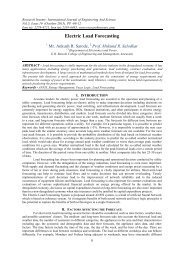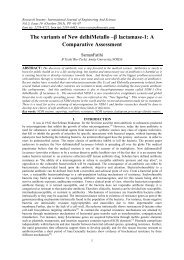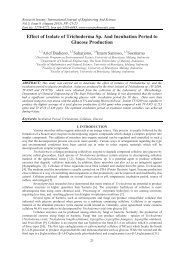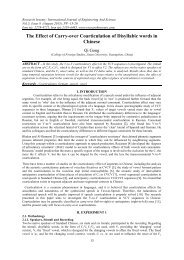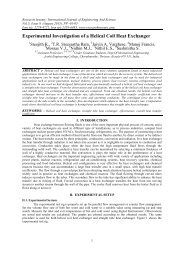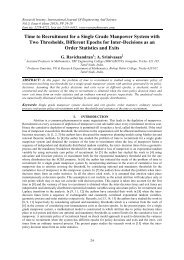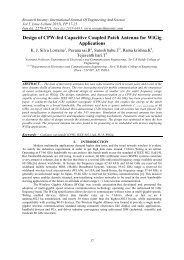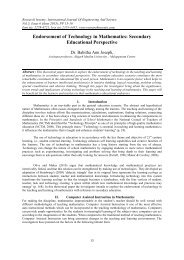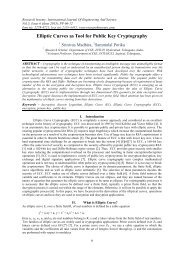Robot social design -Facial expressions
Research Inventy : International Journal of Engineering and Science is published by the group of young academic and industrial researchers with 12 Issues per year. It is an online as well as print version open access journal that provides rapid publication (monthly) of articles in all areas of the subject such as: civil, mechanical, chemical, electronic and computer engineering as well as production and information technology. The Journal welcomes the submission of manuscripts that meet the general criteria of significance and scientific excellence. Papers will be published by rapid process within 20 days after acceptance and peer review process takes only 7 days. All articles published in Research Inventy will be peer-reviewed.
Research Inventy : International Journal of Engineering and Science is published by the group of young academic and industrial researchers with 12 Issues per year. It is an online as well as print version open access journal that provides rapid publication (monthly) of articles in all areas of the subject such as: civil, mechanical, chemical, electronic and computer engineering as well as production and information technology. The Journal welcomes the submission of manuscripts that meet the general criteria of significance and scientific excellence. Papers will be published by rapid process within 20 days after acceptance and peer review process takes only 7 days. All articles published in Research Inventy will be peer-reviewed.
You also want an ePaper? Increase the reach of your titles
YUMPU automatically turns print PDFs into web optimized ePapers that Google loves.
Research Inventy: International Journal of Engineering And Science<br />
Vol.5, Issue 10 (October 2015), PP -26-30<br />
Issn (e): 2278-4721, Issn (p):2319-6483, www.researchinventy.com<br />
<strong>Robot</strong> <strong>social</strong> <strong>design</strong> -<strong>Facial</strong> <strong>expressions</strong><br />
1 Rodolfo Romero Herrera, 2 Bermúdez G.N. Mauricio , 3 Jesús Yalja Montiel<br />
Pérez<br />
1 (Instituto Politécnico Nacional IPN Escuela Superior de Cómputo ESCOM; México D.F.)<br />
2 (Instituto Politécnico Nacional IPN Unidad Profesional Interdiciplinaria en Ingeniería y Tecnologías<br />
Avanzadas UPIITA; México D.F.)<br />
3 (Instituto Politécnico Nacional IPN Escuela Superior de Cómputo ESCOM; México D.F.)<br />
ABSTRACT - This paper addresses the <strong>design</strong> of an emotional robot; which will be able to mimic<br />
some human <strong>expressions</strong> using servomotor.This work focuses on imitates the movements of the eyes,<br />
mouth. In order to make a face having facial <strong>expressions</strong>.We did all the modeling giving versatility, in<br />
order to approach the human face and imitate their movements.Upon completion of all the<br />
mechanisms of emotional robot will be printed using a 3D printing system to complete the<br />
assembly.Design the model of an emotional robot; which can imitate the movements of the eyes,<br />
mouth, arms and fingers of one person to generate different <strong>expressions</strong>, such as joy, anger, sadness,<br />
and fear.<br />
Keywords –<strong>social</strong> robot, mimic <strong>expressions</strong>, face, servo mechanisms, emotions.<br />
I. INTRODUCTION<br />
one of the technologies that is calling powerfully the attention is definitely <strong>social</strong> <strong>Robot</strong>ics; mainly due to the<br />
many applications this can have with service robots; However, to achieve full adaptation to society is necessary<br />
to provide machines simulating feelings. To achieve this, it, we must start with the facial <strong>expressions</strong> of the face;<br />
since it is the part of the body where most observe emotions.<br />
Currently, there are already devices that allows the printing of 3D <strong>design</strong>s, such as printers. Thus the only thing<br />
we should do is to generate planes software tools such as Autocad, Rhinoceros or Solidwork.<br />
SolidWorks software is a CAD (computer aided <strong>design</strong>) for mechanical 3D modeling, currently developed by<br />
SolidWorks Corp.The program allows modeling parts, assemblies and removes them both technical drawings<br />
and other information necessary for the production.It has a vast array of materials and functions allowing for<br />
any project [1].the introduction of the paper should explain the nature of the problem, previous work, purpose,<br />
and the contribution of the paper. The contents of each section may be provided to understand easily about the<br />
paper.<br />
II. DEGREES OF FREEDOM<br />
The number of degrees of freedom refers to the minimum number of parameters that need to specify to fully<br />
determine the speed of a mechanism or number of reactions of a structure [2] [3].A common criterion used to<br />
know the degrees of freedom of a mechanism is called Grubler- Kutzbach criterion:<br />
(1)<br />
Where:<br />
m, mobility.<br />
n, number of elements (links, rods, pieces, etc.) of a mechanism.<br />
j 1 , number of joints of 1 degree of freedom.<br />
j 2 , number of joints of two degrees of freedom.<br />
26
<strong>Robot</strong> <strong>social</strong> <strong>design</strong> -<strong>Facial</strong> <strong>expressions</strong>…<br />
Note: this formula is valid only if there are no redundant links, That is to say links physically appear in the<br />
mechanism but are not necessary for its movement.In order to use the criterion, we must eliminate redundant<br />
links and then calculate the degrees of freedom of the mechanism.<br />
All fixed parts (ground connections) are included as the first element. Although the degree of freedom of some<br />
unions is easy to visualize, at other times can be changed by equivalent systems [2].<br />
Eyes and eyelids<br />
III. ROBOT PARTS<br />
Ocular eyes have a degree of freedom for the axis of elevation and two for the orientation axis, the greater speed<br />
that can be achieved is similar to a human, which is 600 ° / s [4] [5].<br />
Mouth<br />
The human mouth is covered by the upper and lower lips and plays important roles in various activities such as<br />
language and facial <strong>expressions</strong> like smiling [4] [6]. Controlling the opening of the mouth keeps food and fluids<br />
within the oral cavity. The size and shape of the mouth are also critical in oral communication, contributing to<br />
the variety of vocal and consistent sounds [7]. The mouth is an organ used by humans to communicate large<br />
number of <strong>expressions</strong>, through this body can show happiness, sadness, fear, among other <strong>expressions</strong> [8].<br />
WE-4R<br />
IV. TWO SPECIAL ROBOTS<br />
In 2003, the robot WE-4R (Waseda Eyes # 4 Refined) that could express its emotions by using its facial<br />
<strong>expressions</strong>, torso and arms [9] was developed. In 2004, developed WE-4RII (Waseda Eyes # 4 Refined II) by<br />
integrating the robot anthropomorphic robot hand RCH-1, allowing him skills such as emotional expression, the<br />
ability to grasp and touch detection [9] [10].To see figure 1.<br />
KISMET<br />
Fig. 1. WE-4RII<br />
Kismet is a robot equipped to express feelings with 15 DOF (degrees of freedom) that thanks to its numerous<br />
joints. It can simulate a variety of human <strong>expressions</strong>. It is a development of MIT in the late 90s. These degrees<br />
of freedom allow you to simulate emotions such as anger, joy, sadness, worry, concern, disgust, surprise, among<br />
others [11] [12].To see figure 2.<br />
Fig. 2. Expressions generated by Kismet<br />
27
<strong>Robot</strong> <strong>social</strong> <strong>design</strong> -<strong>Facial</strong> <strong>expressions</strong>…<br />
V. DEVELOPING<br />
For the development of the mouth, a joint mechanism 4 in which is held fixed the top center point is proposed.<br />
Thus controlled by the remaining 3 joint movements are possible different <strong>expressions</strong> such as happiness,<br />
sadness, surprise, anger, boredom, among others. The mechanism comprises a mouth 7 different parts assembly<br />
attached to a main frame with a maximum of 3 degrees of freedom and approximate dimensions 106mm X<br />
85mm X 35mm. To reduce the size of the mechanism, it is proposed to use servo HEXTRONIK HXT900.Table<br />
1 shows the mechanisms <strong>design</strong>ed.<br />
Table 1: List of components for the mouth<br />
Number of pieces 1) Component 2) Image<br />
3) 1 4) Main Section<br />
4)<br />
5) 2 6) lateral bolt<br />
6)<br />
7) 3 8) Servomotor HXT900<br />
9)<br />
10) 2 11) Side rail<br />
12)<br />
13) 1 14) lower bolt<br />
15)<br />
16) 1 17) Bottom Rail<br />
18)<br />
19) 3 20) Stopper bolt<br />
To achieve body movements we must consider the minimum engine, and the increase also leads to an increase<br />
in energy consumption.Joining all components, the end mechanism is as shown in the figure 3:<br />
21)<br />
Fig. 3Join the mouth (top, isometric, front, back)<br />
28
<strong>Robot</strong> <strong>social</strong> <strong>design</strong> -<strong>Facial</strong> <strong>expressions</strong>…<br />
EYES<br />
A key to give expression to our face part is the eyes. So care must be taken in its <strong>design</strong>. So we have to use<br />
servomotors dimenciones reduced.The mechanism that makes eyes with 2 degrees of freedom allowing mimic<br />
the movement of a human eye. The mechanism requires 6 different components assembled on a base. For this<br />
mechanism HXT900 two servomotors are used.Table 2 shows the mechanisms <strong>design</strong>ed for the eyes.<br />
Number of<br />
pieces<br />
Table 2: List of component for eyes<br />
Component<br />
Image<br />
1 Home Base<br />
2 Inner coupling eye<br />
2 Eye<br />
2 Servomotor HXT900<br />
2 Lateral eye bolt<br />
2 Superior eye bolt<br />
Joining all components, the end mechanism is as follows:<br />
Fig. 4. Assemble eye (top, side, back, isometric)<br />
29
Figures 5 and 6 we can see the assembly of the head with the mechanisms <strong>design</strong>ed.<br />
<strong>Robot</strong> <strong>social</strong> <strong>design</strong> -<strong>Facial</strong> <strong>expressions</strong>…<br />
Fig. 5. Three dimensional view ofthe head.<br />
Fig. 6. Front viewof the head.<br />
In Figure 7 the head is observed <strong>design</strong>ed placed on a back of a robot.<br />
Fig. 7. Mounting therobothead onback<br />
VI. CONCLUSION<br />
The <strong>design</strong> of an affective robot requires several different mechanisms to mimic human expression; However,<br />
try to imitate this type of mechanism is a complex task and that to achieve the full camouflage is necessary<br />
various actuators and motors working together in a small space.<br />
Although this <strong>design</strong> is relatively simple, the mechanisms that allow the movement required of imagination and<br />
search various references to understand and simplify movements; allowing, get different <strong>expressions</strong> with a<br />
small number of actuators / motors such as hands and mouth.It is obtained as the endresult<strong>design</strong>ing<br />
arobotcapableof expressingemotions.<br />
ACKNOWLEDGEMENTS<br />
The authors acknowledge the support received by the Instituto Politécnico Nacional (IPN)Escuela Superior de<br />
Cómputo (ESCOM) for the realization of this project.<br />
REFERENCES<br />
[1] Solidworks.es, 'Inicio', 2015. [Online]. Available: http://www.solidworks.es/. [Accessed: 13- Nov- 2015].<br />
[2] S. Saha, Introducción a la robótica. México: McGraw-Hill, 2010.<br />
[3] S. Smith-Berdan, K. Schepers, A. Ly, E. Passegué and E. Forsberg, 'Dynamicexpression of the Robo ligand Slit2 in<br />
bonemarrowcellpopulations', CellCycle, vol. 11, no. 4, pp. 675-682, 2012.<br />
[4] S. Jacob and C. Francone, Anatomía y fisiología humana. México, D.F.: Interamericana/ McGraw-Hill, 1983.<br />
[5]' TokyoUniversity'sSusumuTachiregardsworldthrough robot eyes', Industrial <strong>Robot</strong>, vol. 28, no. 5, 2001.<br />
[6] H. Wen, M. Cong and G. Wang, 'Experimental verification of workspace and mouth-openingmovement of a<br />
redundantlyactuatedhumanoidchewing robot', Industrial <strong>Robot</strong>, vol. 42, no. 5, pp. 406-415, 2015.<br />
[7] J. Velayos and H. Díaz Santana, Anatomía de la cabeza. Madrid: Panaméricana, 1994.<br />
[8] R. Thompson, Fundamentos de psicologíafisioló gica. México, D.F.: Trillas, 1973.<br />
[9] Zecca, M.; Chaminade, T.; Umilta, M.A.; Itoh, K.; Saito, M.; Endo, N. Emotional Expression Humanoid <strong>Robot</strong> WE-4RII-<br />
Evaluation of the perception of facial emotional <strong>expressions</strong> by using fMRI.<br />
[10] J. Babič and E. Oztop, Humanoid robot skillacquisitionthrough balance interactionbetween human and humanoid robot. .<br />
[11] Breazeal, C. (1999), "<strong>Robot</strong> in Society: Friend or Appliance?".In Agents99 workshop on emotion-based agent architectures,<br />
Seattle, WA. 18-26.<br />
[12] 2015. [Online]. Available: http://www.ai.mit.edu/projects/humanoidroboticsgroup/kismet/kismet.html. [Accessed: 13- Nov-<br />
2015].<br />
30


